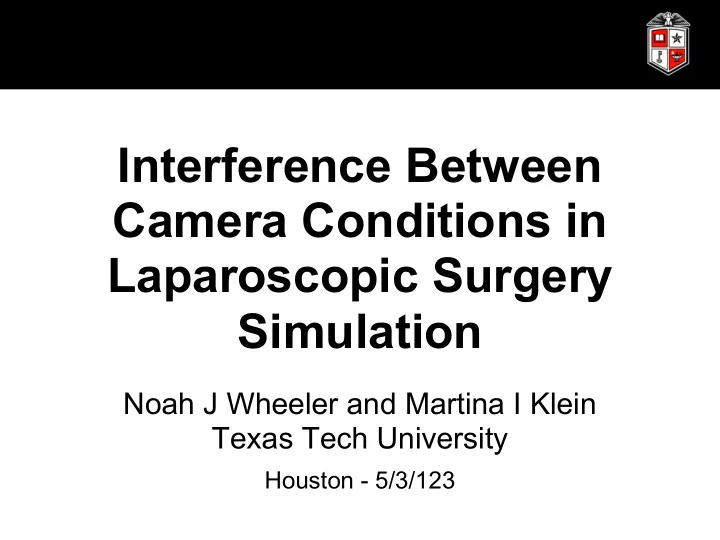

Interference Between Camera Conditions in Laparoscopic Surgery Simulation Noah J Wheeler and Martina I Klein Texas Tech University Houston - 5/3/123
Laparoscopic surgery ● Long thin graspers inserted through incisions ● Surgical field viewed via camera and monitor ● Poses perceptual-motor challenges Photo: www.defence.gov
Camera placements 0 Degrees Movement on Monitor Grasper Movement Surgeon
Camera placements 45 Degrees Movement on Monitor Grasper Movement Surgeon
Camera placements 90 Degrees Movement on Monitor Grasper Movement Surgeon
Camera placements 135 Degrees Movement on Monitor Grasper Movement Surgeon
Camera placements 180 Degrees Movement on Monitor Grasper Movement Surgeon
Camera placements 225 Degrees Movement on Monitor Grasper Movement Surgeon
Work we have done ● The results of our previous research ○ Peak error lies between 90 and 135 degrees (1) 1. Wheeler, Klein, & Craig, 2012
Previous related work ● Other laparoscopic research ○ Experts' peak error lies closer to 180 degrees (1) 1. Ames, Frisella, Yan, Shulam, & Landman, 2006
Otmar Bock ● Rotated visual feedback (1) ○ Participants used different processes ■ Less than 113 degrees ■ Greater than 113 degrees ○ These two types of processes interfered with each other ● Used a 2D task 1. Bock, Abeele, & Eversheim, 2003
Objectives ● Long-term goal ○ To improve surgical performance ● Objective of this study ○ To see if interference occurs between camera conditions ● Central hypothesis ○ Experience with camera rotations less than 113 degrees will interfere with performance in camera conditions greater than 113 degrees
Rationale ● Provide the basis for research that improves flexibility ○ Ensure equivalent performance in all camera locations ○ Surgeons sometimes have to switch multiple times between camera port placements (1) ● Development of training programs ○ Support camera switching ○ Decrease movement error 1. Ferzli & Fingerhut, 2004
This work will be . . . ● Innovative ○ Applies basic movement research to the laparoscopic training environment ● Beneficial ○ Provide possible explanation of variance in surgeons' performance ○ Set the stage for the development of training programs ■ Decrease injury due to surgical lacerations ■ Decrease operation times ■ Improve patient outcomes
Methods Participants: Task: ● 19 males 23 females Target pointing task in a ● Normal or corrected to laparoscopic simulator normal vision using a model surgical ● Ages 18 to 23 grasper. Data collection: Procedure: Electromagnetic motion ● 2 familiarization blocks tracker recorded tip of ● 14 practice blocks model grasper at 240 Hz. ● 1 experimental block
Methods - Apparatus
Design Familiarization Practice Blocks Experimental Blocks (2) (14) Block (1) 135 degrees 45 degrees 180 degrees 225 degrees Direct view of task 135 degrees Direct task view 180 degrees 225 degrees
Measurement Deviation (d) Ideal Observed Target
Results - RMSE Control Pre-exposed to 45 degrees
Results - Time Control Pre-exposed to 45 degrees
Conclusions Theoretical implications: ● Previous experience with visuomotor distortions alters the relationship between visuomotor rotations and performance Practical implications: ● Training programs for surgeons Future directions: ● See if experts exhibit similar patterns Photo: www.chronogram.com
Questions?
References Ames, C., Frisella, A. J., Yan, Y., Shulam, P., & Landman, J. (2006). Evaluation of laparoscopic performance with alteration in angle of vision. Journal of Endourology, 20 , 281-284. Retrieved from EBSCO host . Bock, O., Abeele, S., & Eversheim, U. (2003). Human adaptation to rotated vision: Interplay of a continuous and a discrete process. Experimental Brain Research, 152 , 528-532. Ferzli, G., & Fingerhut, A. (2004). Trocar placement for laparoscopic abdominal procedures: a simple standardized method. Journal Of The American College Of Surgeons , 198(1), 163-173. Retrieved from EBSCO host . Wheeler, N. J., Klein, M. I., & Craig, C. (2012). Camera placement in simulated laparoscopic surgery influences performance. Proceedings of the Annual Meeting of the Human Factors & Ergonomics Society, 56 , 1346-1350.
Recommend
More recommend